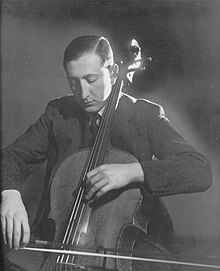Pál Hermann
Pál Hermann , also Paul Hermann or Pal Hermann , (born March 27, 1902 in Budapest , Austria-Hungary , † after 1944 ) was a Hungarian cellist and composer .
Life
Pál Hermann was born on March 27, 1902 in Budapest to a Jewish family . Little more than a little anecdote has come down to us from his early childhood. He only prepared for his piano lessons when he received a filler for every étude he had studied . He studied at the Franz Liszt Music Academy from 1915 to 1919 and maintained close musical and personal relationships with his composition teachers Béla Bartók and Zoltán Kodály , the violinist Zoltán Székely , and the pianists Géza Frid and Lili Kraus .
At the Franz Liszt Music Academy he studied cello under Adolf Schiffer and first composition under Leó Weiner , who was also his chamber music teacher . Even during his student days, Hermann often played inside and outside the Liszt Academy. At the age of 16 he began his international cello career as a soloist. During the first years of his career, Hermann frequently visited London to perform recitals and concerts. He lived in the house of the Graaff-Bachiene family, who were among the patrons of the arts.
During a stay in Holland around 1929, Jaap de Graaf recommended his niece Ada Weevers, who lived in Amersfoort, to see a performance by Hermann in Amsterdam. When they met, they fell in love with each other despite their different cultural, national, and religious affiliations. In 1930 the couple moved to Berlin . In 1932 they had a daughter, Corrie Hermann . From 1929 to 1934 Hermann taught cello and composition at the municipal folk and youth music school in Neukölln . In November 1933 Ada drowned in an accident in the North Sea. When the political climate in Berlin became more and more threatening for Jews, he decided to move his daughter to live with her grandparents in the Netherlands . From 1934 to 1937 Hermann worked in Brussels and from 1937 to 1939 in Paris . At the beginning of German fighting in the western campaign in 1940, he signed up for the "23e regiment de marche des volontaires étrangers". After the German occupation of northern France, he moved to Vichy France near Toulouse , where he was hidden in a farmhouse that belonged to the French branch of the Weevers family. There he composed three melodies for voice and piano ( Ophelie , La Centure , Dormeuse ) and the sonata for violin and cello. The Ophelie composition is based on Hamlet's Ophelia, who drowns in a river, is probably inspired by the death of his wife by drowning.
Last years
Having found it difficult to cope with the loneliness of his hidden life on the farm, he went to Toulouse from time to time to teach and socialize , taking the risk of being caught by the police of the Vichy- Regime to be discovered. During one such stay, he was arrested as part of a street raid and sent to the Drancy concentration camp in the spring of 1944 . On May 15, 1944 he was deported with the 73rd convoy from Drancy to the Baltic States occupied by the German Reich . Since then there has been no trace of Hermann.
Compositions
Hermann often performed recitals or played chamber music with the Hungarian quartet, with the violinist Zoltán Székely and others. Only the programs of his concerts and recordings have survived. The Prinz-Bernhard-Kulturfonds founded the Paul-Hermann-Fonds in memory of him. He grants scholarships to promising young cellists from the Franz Liszt Academy.
Hermann left behind a small number of compositions, all of which are publicly available in Europe.
- Grand Duo, pour violon et violoncelle (1929–30)
- Duo pour violon et violoncelle (1920, dédié a Zoltán Székely )
- Trio à cordes (1921)
- Toccata, pour piano (1936)
- Quatre Épigrammes, pour piano (1934)
- Trois mélodies sur des textes d ' Arthur Rimbaud et de Paul Valéry , extrait de Charmes (1934–39)
- Ophélie
- La Ceinture
- La Dormeuse
literature
- Eve Line Blum-Cherchevsky : Nous Sommes 900 Francais . Volume 7. Blum, Besançon 1999, ISBN 2-9513703-0-X , pp. 362-364.
- Claude Kenneson: Székely and Bartók: the story of a friendship. Amadeus Press, Portland 1994, ISBN 0-931340-70-5 ( limited preview in Google Book Search).
Web links
- Paul Hermann (1902-1944) , at Leo Smit Foundation
- Corrie Hermann: Paul Hermann (1902-1944), violoncelliste et compositeur , with Claude Torres: Mes musiques régénérées (fr, en)
- "Pal Hermann attended those ISCM concerts ..."
Individual evidence
- ^ Howard Smith: New Zealand String Quartet choses to air long-neglected work. In: nzherald.co.nz . January 7, 2001, accessed May 4, 2020.
- ↑ Hermann Paul 03/27/02 Budapest , in the list of names in Convoi 73. See Ève Line Blum-Cherchevsky: Nous sommes 900 Français: à la mémoire des déportés du convoi n ° 73 ayant quitté Drancy le May 15, 1944 . Besancon, 1999-2006.
- ^ Notes and audio files by Pál Hermann in the International Music Score Library Project
| personal data | |
|---|---|
| SURNAME | Hermann, Pál |
| ALTERNATIVE NAMES | Hermann, Paul; Hermann, Pal |
| BRIEF DESCRIPTION | Hungarian cellist and composer |
| DATE OF BIRTH | March 27, 1902 |
| PLACE OF BIRTH | Budapest |
| DATE OF DEATH | after 1944 |
